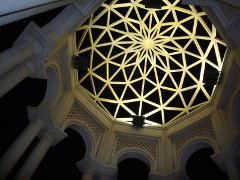It is a curious fact that no edge-to-edge regular polygon tiling of the plane can include a pentagon.
Introduction

For thousands of years architects and artists have covered floors, walls and ceilings with tilings created by gluing together many copies of a small set of regular shapes. The simplest tilings are composed of only one shape such as rectangles or diamonds. Artists have explored more complex possibilities. Muslim palaces such as the Alhambra are decorated with intricate geometric patterns formed from stars, diamonds and other complex shapes. The Dutch artist Maurits Escher formed tilings from shapes representing birds, frogs, and even angels and devils.
This website explains the basic mathematics of a particular class of tilings of the plane, those involving regular polygons such as triangles or hexagons. As will be shown, certain combinations of regular polygons cannot be extended to a full tiling of the plane without involving additional shapes, such as rhombs. The site contains some commentary on Renaissance research on this subject carried out by two renowned figures, the mathematician-astronomer Johannes Kepler and the artist Albrecht Dürer.
Imperfect Congruence requires nothing beyond high school level mathematics and gives examples of many beautiful tilings, including some that do not appear to have been published before.
